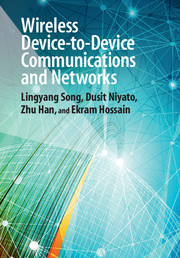Book contents
- Frontmatter
- Dedication
- Contents
- Preface
- Part I Introduction
- Part II Techniques for modeling and analysis of D2D communications
- Part III Resource management, cross-layer design, and security for D2D communications
- 4 Mode selection and resource allocation for D2D communications underlaying cellular networks
- 5 Interference coordination for D2D communications
- 6 Subchannel allocation and time-domain scheduling for D2D communications
- 7 Cross-layer design for device-to-device communication
- 8 Security for D2D communications
- Part IV Applications of D2D communications
- Part V Standardization of D2D communications
- References
- Index
5 - Interference coordination for D2D communications
from Part III - Resource management, cross-layer design, and security for D2D communications
Published online by Cambridge University Press: 05 March 2015
- Frontmatter
- Dedication
- Contents
- Preface
- Part I Introduction
- Part II Techniques for modeling and analysis of D2D communications
- Part III Resource management, cross-layer design, and security for D2D communications
- 4 Mode selection and resource allocation for D2D communications underlaying cellular networks
- 5 Interference coordination for D2D communications
- 6 Subchannel allocation and time-domain scheduling for D2D communications
- 7 Cross-layer design for device-to-device communication
- 8 Security for D2D communications
- Part IV Applications of D2D communications
- Part V Standardization of D2D communications
- References
- Index
Summary
D2D communication may cause undesirable interference to primary cellular users due to spectrum sharing. This chapter focuses on interference coordination for D2D communications underlaying cellular networks.
Interference analysis
D2D communication not only provides coverage at the customer's premises, but also radiates toward neighboring mobile users, introducing interference. Owing to this and given that D2D communication typically is performed within the coverage area of existing macro/micro cells, it can cause severe degradation of the cellular network’ sperformance. Furthermore, the occurrence of new D2D networks could also disturb the normal functioning of already-existing D2D communications. Therefore, to reduce the appearance of dead zones within cellular networks and successfully enable a D2D LAN, interference avoidance, randomization, or cancellation techniques must be applied.
In the following, it is assumed that the D2D users are synchronized with the cellular networks as well as with other D2D users. Therefore, considering that the networks define two separate layers (the D2D and cellular layers), interference can be classified as follows.
• Cross-layer interference: This refers to situations in which the aggressor (e.g., a D2D user) and the victim (e.g., a cellular user) of interference belong to different network layers.
• Co-layer interference: In this case the aggressor (e.g., a D2D user) and the victim (e.g., a neighboring D2D user) belong to the same network layer.
Interference avoidance
To overcome the adverse effects of interference, cancellation techniques have been proposed, but they are often disregarded due to errors in the cancellation process [183]. The use of multiple antenna beamforming at the mobile has also been suggested as a means of reducing interference by decreasing the number of interferers. By contrast, strategies based on interference avoidance also represent efficient alternatives (e.g., power and subchannel management).
Power-control algorithms and radio-resource management are tools that are often used in cellular systems to mitigate interference. If they are not applied, users located far from an eNB will be jammed by users in much closer positions. These techniques are also necessary in D2D communications for the same reasons plus the added problem of cross-layer interference.
- Type
- Chapter
- Information
- Wireless Device-to-Device Communications and Networks , pp. 160 - 172Publisher: Cambridge University PressPrint publication year: 2015



